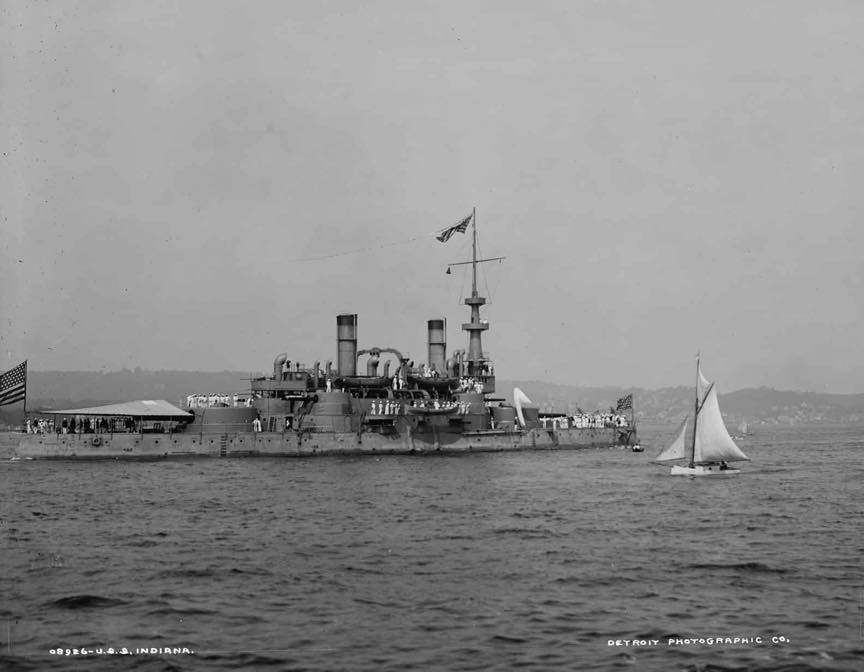USS Indiana BB-1

Indiana I
Indiana, the 19th State, was admitted to the Union 11 December 1816, and was named because it had been the home of Indians.
(BB-1: dp. 10,288 n.; 1. 350'11"; b. 69'3"; dr. 24'; s. 15 k.;
cpl. 473; a. 4 13", 8 8", 4 6", 20 6-pdr., 6 1-pdr. )
The first Indiana (BB-1) was laid down on 7 May 1891 by William Cramp & Sons, Philadelphia; launched on 28 February 1893; sponsored by Miss Jessie Miller, daughter of the Attorney General of the United States, and commissioned on 20 November 1895 with Captain Robley D. Evans in command. Following fitting out at Philadelphia Navy Yard, Indiana trained off the coast of New England. This duty continued until the outbreak of the Spanish-American War in 1898, when Indiana formed part of Admiral Sampson's squadron. The 10 ships sailed south to intercept Cervera's Spanish squadron, known to be en route to the Caribbean. Indiana took part in the bombardment of San Juan on 12 May 1898, and returned to Key West with the squadron to guard Havana on 18 May. After it was discovered that Cervera was at Santiago, Sampson joined Schley there on 1 June and took up the blockade.
In late June, Army units arrived and were landed for an assault on Santiago. Cervera saw that his situation was desperate and began his gallant dash out of Santiago on 3 July 1898, hoping to outrun the American blockaders. Indiana did not join in the initial chase because of her extreme eastern position on the blockade but was near the harbor entrance when destroyers Pluton and Furor emerged. In a short time, both ships were destroyed by Indiana's guns and those of the other ships. Meanwhile, the remaining Spanish vessels were sunk or run ashore, in one of the two major naval engagements of the war.
Indiana returned to her previous pattern of training exercises and fleet maneuvers after the war and made practice cruises for midshipmen of the Naval Academy before decommissioning on 29 December 1903.
The battleship recommissioned at New York Navy Yard on 9 January 1906. During this phase of her career, Indiana served with the Naval Academy Practice Squadron, sailing to Northern Europe and the Mediterranean. At Queenstown, Ireland, she fired a 21-gun salute on 22 June 1911 in honor of the coronation of King George V. This important work in training the Navy's future leaders ended in 1914, and she decommissioned at Philadelphia on 23 May 1914.
Indiana recommissioned a second time on 24 May 1917 and served through World War I as a training ship for gun crews off Tompkinsville, N.Y., and in the York River, Va. She decommissioned at Philadelphia on 31 January 1919. The name Indiana was canceled on 29 March 1919, and she was reclassified as Coast Battleship Number 1 so that the name could be assigned to a newly authorized battleship. She was used as a target in an important series of tests designed to determine the effectiveness of aerial bombs and was sunk in November 1920. Her hulk was sold for scrap on 19 March 1924.
 >
>